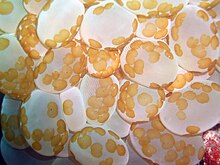Acoelomorph
| Acoelomorpha | |
|---|---|
 |
|
| Waminoa sp. on Plerogyra sp.. | |
| Scientific classification | |
| Kingdom: | Animalia |
| Phylum: | Xenacoelomorpha |
| Subphylum: |
Acoelomorpha Ehlers, 1985 |
| Subgroups | |
Acoelomorpha is a subphylum of very simple and small soft-bodied animals with planula-like features that live in marine or brackish waters. They usually live between grains of sediment, swimming as plankton, or crawling on other organisms, such as algae and corals.
Traditionally, based on morphological characters, Acoelomorphs were considered to belong to the phylum Platyhelminthes, which was at that time seen as the sister group to all other bilaterian phyla. However, a series of molecular studies since the end of the 20th century demonstrated that they belong to a separate phylum, most likely as basal bilateral animals slightly more derived than cnidarians.
The true position of Xenacoelomorpha was not yet well defined, as some results showed them as belonging to the deuterostomes. However, reanalyses and increased taxon and gene sampling in phylogenomic analyses favor the placement of Xenacoelomorpha as sister group to Nephrozoa with good support.
Acoels have a , which presumably helps them orient to gravity. Their soft bodies make them difficult to classify.
Acoelomorphs resemble flatworms in many respects, but have a simpler anatomy, not even having a gut. Like flatworms, they have no circulatory or respiratory systems, but they also lack an excretory system. They lack body cavities (acoelomate structure), a hindgut or an anus.
The epidermal cells of acoelomorphs are unable to proliferate, a feature that is only shared with rhabditophoran flatworms and was for some time considered a strong evidence for the position of Acoelomorpha within Platyhelminthes. In both groups, the epidermis is renewed from mesodermal stem cells.
The nervous system of acoelomorphs is formed by a set of longitudinal nerve bundles beneath the ciliated epidermis. Close to the anterior end, these bundles are united by a ring comissure, but do not form a true brain, although it is hypothesized that such organization was the precursor of the cephalization of the nerve system in more derived bilaterians.
...
Wikipedia
